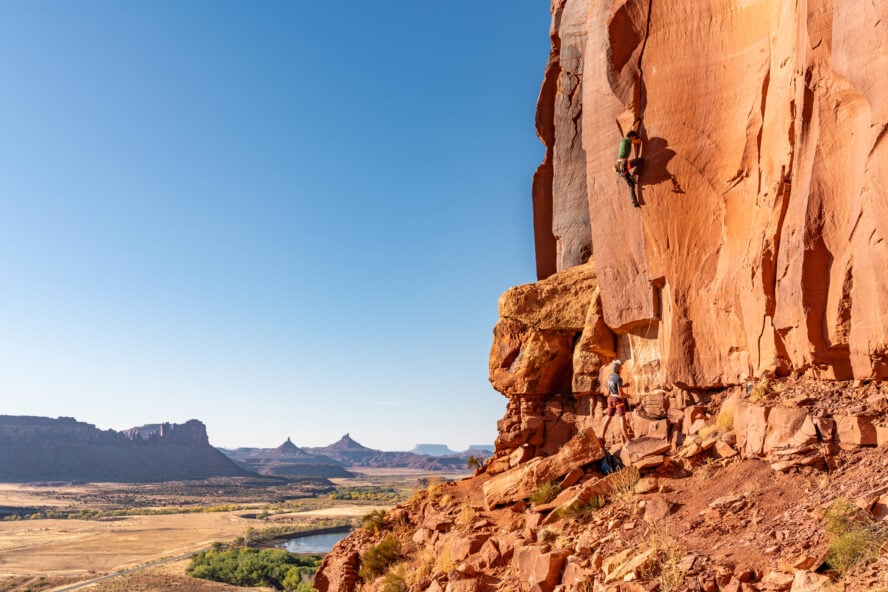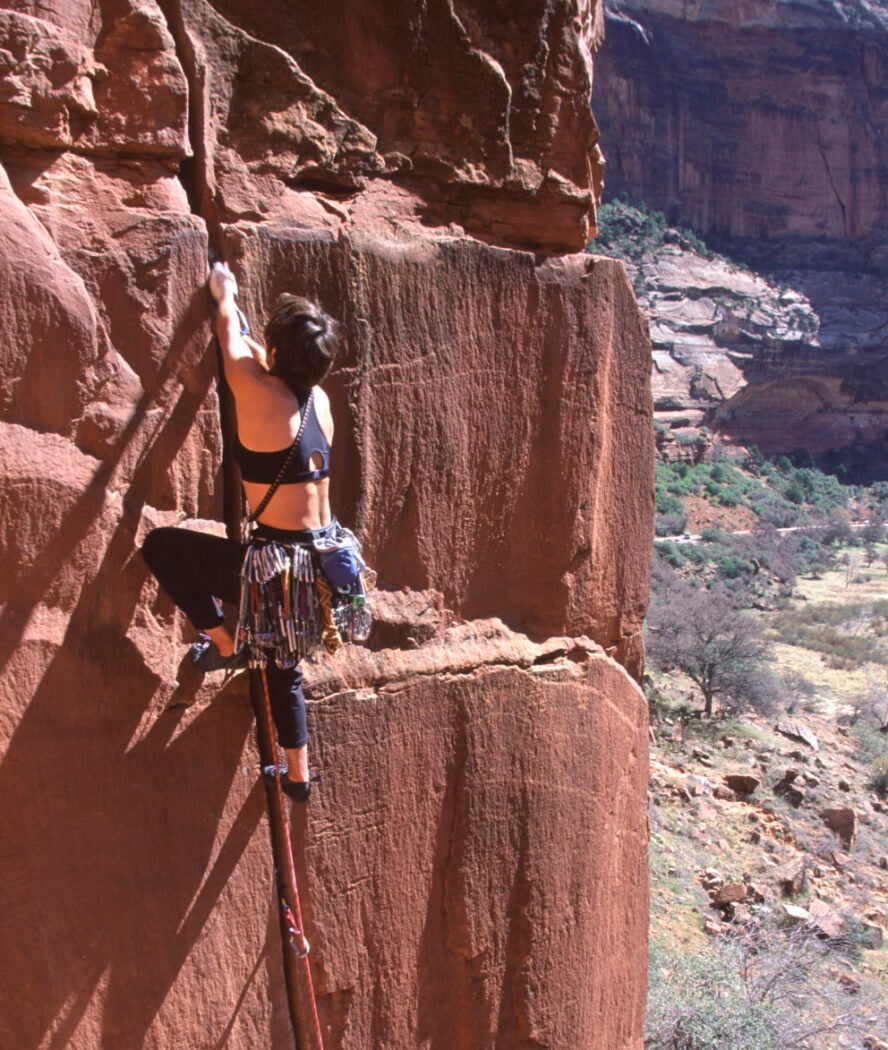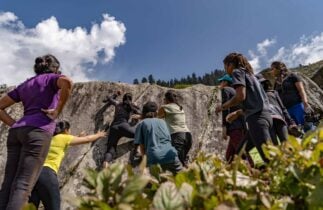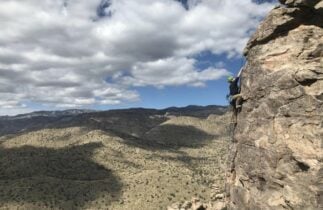The Ultimate Guide to the Best Rock Climbing in Utah
Table of Contents
Utah is my favorite state for rock climbing, which is saying a lot given my ties to North Carolina and Nevada. In few other states can you find the hardest granite, weirdest conglomerate, and the softest sandstone in the entire country in a 6-hour drive.
Utah is the land of Indigenous peoples, including the Ute, Shoshone, Western Shoshone, Goshute and several smaller tribes, as well as the Latter Day Saints (Mormons), desert people, mountain people, skiers, snowboarders, off-road enthusiasts, and climbers. And you’ll find lots and lots of climbers!

Climbing Utah’s four distinct regions
I like to think of Utah climbing in four parts. Eastern Utah, where we find Moab, Indian Creek, and the La Sals, is largely the land of sandstone. Salt Lake City is its own designation, in my mind, spanning from Logan limestone climbing in the north to the incredible quartzite and white granite of the Cottonwood Canyons nearest town. Central Utah is often sparsely populated farmland and mountains where you will find the interesting conglomerate of Maple Canyon and the hard sandstone of Joe’s Valley. Southwest Utah is where you can find just about any climbing you are looking for. You’ll discover limestone caves, basalt, and varying sizes of sandstone faces and cracks.
Eastern Utah is a journey to the land of red stone
When I think about climbing in Utah, the first place I typically think of is the Colorado Plateau. Situated in Eastern Utah, this is the land of the Ute and Navajo. The red stone is rife with the history of human success, struggle and conflict. It is a climbers paradise where the Wingate sandstone and desert towers of varying composition are the stars of the show. Eastern Utah climbing also offers some of the state’s greatest hits, including the following heart-pounding climbs in Moab and Indian Creek.
Let’s take a journey to these destinations and let me show you why Utah is a climber’s paradise!
1. Moab
No trip to this vast area is complete for me without a visit to Moab, the beating heart of Utah’s adventurous landscape and one of the best rock climbing locations in the USA. Originally called Mohapa (Mosquito Water) by the Ute, it was renamed by Mormon settlers to Moab after the biblical city described as bearing a resemblance to the lush, green valley that is now the town we love. The climbing around Moab is as varied as the adventure sports that can be done here.

Something for every style of climber
Every single type of outdoor activity may be found here. For climbers, Moab offers a feeling of abundance that is palpable. Sport climbers can find well-bolted, moderate climbing at locations such as the Cinema and Theater on River Road. More stout climbing is available at locations such as The Portal on Potash Road and at Mars and The Scar.
Boulderers can find their projects at major areas such as Big Bend Boulders on River Rd or test their overhanging crack techniques low to the ground at the Crack House. Want to climb a splitter? Areas such as Day Canyon and Longs Canyon have you covered thanks to Maverick Buttress and routes including Brush Painted Datsun.
Moab’s incredible desert towers
Try your hand at climbing Moab’s incredible towers in Castle Valley where formations such as the Priest, Castleton and The Rectory can be found. I find routes like Kor-Ingalls and Fine Jade an absolute delight. Want to test your aid climbing abilities to the max? Few areas will challenge the serious aid climber like the Fisher Towers near Castle Valley, the largest free-standing tower in the United States and home to routes that rival the climbing at Devil’s Tower. At Fisher, you’ll have your face and gear caked in mud—and fear is the name of the game. I also recommend attempting routes such as the Finger of Fate on the Titan. It draws the willing from all over!

The best time of year to visit Moab
My favorite time of year to rock climb in Moab is the fall. The trade-off is potentially more wet, unstable weather. Word of the wise, you’ll want to give it 2-3 days to dry after a rainfall before heading out. Embarking on a bit of a guessing game is worth seeing the changing colors of the cottonwoods and aspens, coupled with the typically temperate weather providing a climber’s paradise. Some may bemoan the crowds, and while I certainly love a quiet route or crag, the crowds are a symptom of some of the best conditions to climb in.
The other best time of year to visit Moab is in the spring from March to May, where temperatures can often be colder and the landscape of trees still barren, but you’ll claim your routes with far fewer crowds competing for space.
The annual Moab climbing festival
The other benefit of fall climbing in Moab is all of the activities going on. Along with the weather, climbing festivals such as the American Alpine Club’s Moab Craggin’ Classic come to town during this time of year. Participating in this festival is a great way to connect with pro locals and local crushers. Plus, you can take technical clinics, climbing clinics, and most importantly, give back to the area with a service day on the third day of the festival. You won’t want to skip this day!
Camping in Moab is a competitive sport of its own
When rock climbing in Moab, finding a place for me to recharge while staying has always been important, and sometimes a struggle. Typically, I am out in Castle Valley or further south in Indian Creek where free camping on Bureau of Land Management (BLM) land is abundant and first come, first served. However, finding a location to camp for free can be challenging due to the proximity to the wildly popular Arches National Park.

These days, I typically pay for camping on Potash Road or River Road at one of the many riverside campgrounds that’ll set you back only $15-35 per night. Free lands do exist just south of Moab off of Yellow Circle Road. The catch is you will often sleep next to loud atv’s traversing rough roads and plenty of late-night crowds. Moab is also a hot spot for motor heads, which for some, only adds to the appeal. There’s a bit of cell coverage and it’s close to town so many find this a reasonable option. Less crowded, and potentially quieter road-side camping exists up in the La Sal Mountains off of La Sal Loop Road. Quiet also translates to remote, so there is no cell coverage. You can also be up to 40 mins from town and the elevations are 2,000 feet higher than town — that means colder, so pack accordingly.
Where to Eat in Moab
Hungry? For being a small desert town, Moab has an incredible selection of shops and eateries. I, however, seem to always end up at either Moab Brewery or Singha Thai Cuisine. Red Rock Bakery and Cafe is just an awesome way to start a rest day!
The Moab rock climbing is as varied as the rock formations themselves. You’ll want a mountain of cams in all sizes, so bring yours and all your friends’ cams to protect the parallel-sided splitter cracks of the Wingate sandstone.
From Cody Bradford’s Everything You Need to Know About Rock Climbing in Moab, Utah
Read full review



1. Moab - Good to Know
Sport, trad, aid, bouldering
Sandstone (Wingate, Kayenta, Navajo, Carmel, Entrada)
Year-round, but best weather is Oct-Nov and Mar-May
My favorite is Karl Kelly’s High on Moab: Moab Climbs
Hiking and mountain biking in Moab; canyoneering in Arches National Park;
Creek Pasture, Potash Ponds (limited and high clearance), Yellow Rd (BLM south of Moab), and any number of hotels in Moab
Jackson Hole Mountain Guides
Day Canyon, The Cinema, Utopia, Big Bend Boulders
2. Indian Creek
Few rock climbing styles bring my psyche to 100 like crack climbing in Indian Creek. Straight, parallel-sided cracks without face features offer respite from the consistent, sustained technique required to send. Millimeters of difference in size along my journey up the crack require subtle changes in technique, making for a very cerebral experience. Nowhere can you immerse yourself so fully in this experience, and in such a stacked area, than in Indian Creek, also known as Bears Ears National Monument.

Where to start your climb in Indian Creek (learn from my mistakes)
Many folks will want to immediately head to the classics upon their arrival to Indian Creek. The classics are, after all, what makes this location the best in the USA for crack climbing. During my first trip to the Creek, I too wanted the classics. So, I went straight to Supercrack Buttress and sought out Supercrack of the Desert. Turns out, big mistake! I struggled, flailed and thrutched my way up the climb in fear, hanging on every piece. Other beginners, with some foresight, arrived after having spent their first climb top roping and training their crack technique for this area.
When I bring people here for the first time, especially if they have never climbed cracks before, I like to instead take them to areas that are off the beaten path. If you can, reserve three days out of your Indian Creek Trip for taking a crack clinic. I recommend the following short climbs to introduce people new to the rock climbing style.
My favorite beginner-friendly climbs
My favorite areas to learn cracks have short routes with a variety of sizes in the hand range. Yes, you will be measuring the crack size with your body parts. Areas such as Selfish Wall are around 40-80 feet tall, with many hand sizes of cracks— my favorite is Hand Solo, (5.9)—including modern hardware that will be used often. Nuclear Wall (aka Sinbad Wall) is another great beginner area with plenty of challenging routes, and is often overlooked. This area, just on the other side of the perma-crowded Battle of the Bulge, contains short routes with plenty of hand sizes. You’ll also find top ropes on harder routes after ascending the easier terrain. Take it from me, after a bit of exercising the thumb meat, and getting into a rhythm, you’ll be able to blast off to those classics you so desperately desire!
While the Creek does not have its own climbing festival yet (good thing too given the crowds here), Friends of Indian Creek and the Access Fund often host trail maintenance events. Your assistance helps maintain these spaces for everyone, so I highly recommend participating in a stewardship day if you are in the area and have a day to spare! I’m a firm believer, if a climbing destination is so important to you that you are willing to take the time to visit, then take the time to give back!

Get away from it all at these remote Indian Creek camping options
The camping may be the best part of rock climbing in Indian Creek. Regardless of your desire to pay or camp for free, you will not forget the views, friendship, and depending on where you choose to stay, the adventure of the overnight stays. Camping at Indian Creek is rustic. You’ll have no cell service, no water, no restaurants or other amenities apart from pit-toilets in certain parking areas and paid campsites.
Creek Pasture and Superbowl feature paid campsites with maintained pit-toilets, flat camping areas that are creekside, and some of the best views and fire-pits. Plus, camping is only $15 per night. Sites are located roadside and right on the actual Indian Creek. Plus the campgrounds offer no-nonsense, easy-to-access sites like those you’d find climbing in Joshua Tree, allowing you to spend your time in style, whether you’re in a van, tent or simply bivying under the stars.
For free, designated campsites, you can find your home at Bridger Jack or Cottonwood campgrounds. You’ll need a ride with a high clearance, sometimes 4X4 depending on road conditions.. Word of warning, limited spots are available, and it is illegal to camp outside of the site boundaries. Get there early or have friends who can!
Free camping options near Indian Creek climbing areas
Apart from first come, first served camping, there is ample BLM camping in certain areas of the Creek. One notable destination is on the “road” to the Shock and Awe area. Crossing through a gate (be sure to close it behind you), you might feel like you’re trespassing, however it is perfectly acceptable to be on this portion of land that’s also used by cattle ranchers. After some ups and downs, you will arrive at a giant, open field where you can park (please, politely making room for others) and camp. Keep in mind that it is often considered poor form to camp in the parking areas of crags, especially the popular areas.
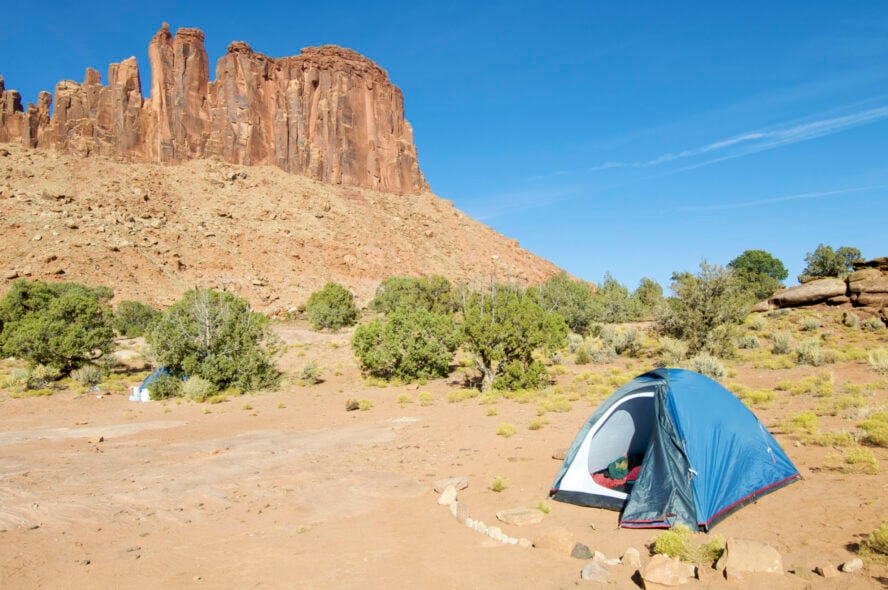
Need-to-know info for climbing in Indian Creek
Looking for a quick bite, gear shop, bike, ski, climbing, coffee, shower and literally anything you can think of? Head straight over to Monticello and Roam Industry. Monticello is way less crowded than Moab and much closer with amazing service. Roam is my go-to destination for all of the things I need to stay comfortable and psyched while staying in the Creek! To reach this crack climbing hot spot, take US HWY 191 south out of Moab or north from Monticello. You’ll reach UT HWY 211 that heads east towards “the Creek”. After 12 miles, you will descend into the canyon and reach News Paper Rock or Tse Hane in Navajo, a swath of rock covered in Petroglyphs from the Indigenous people that first inhabited this land. I always stop on my way in to pay homage to the Navajo people that called this place home for so many years. It’s my way of signifying a start to a great trip!
Indian Creek’s perfect splitter cracks call to be climbed. Climbing “the Creek” is about thinking with your hands, feet, fingers, arms, and entire body to create the holds needed to make upward progress on these splitters.
Read Cody Bradford’s Indian Creek: Home of the Best Crack Climbing in the USA

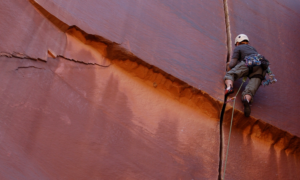


2. Indian Creek - Good to Know
Traditional crack climbing
Wingate Sandstone
Spring, fall, winter
Donnelly Canyon, Selfish Wall, Hand Solo, Nuclear Wall
Creek Freak: Indian Creek Climbs by Karl Kelly
Hiking, mountain biking, skydiving, skiing (Abajos/ La Sals)
Creek Pasture and Superbowl at $15 per night, Bridger Jack or Cottonwood are free
Jackson Hole Mountain Guides; Red River Adventures
3. Salt Lake City
The Cottonwood Canyons are the big climbing draw
Can Salt Lake City possibly have any more to offer the outdoor oriented? I’m a huge fan of this town and climbing near Salt Lake City get two thumbs up from me. The points of interest here are the Cottonwood Canyons. Located southeast of downtown Salt Lake City, in the Wasatch mountain range and running up the canyon from west to east, Big and Little Cottonwood Canyons hold a high spot in climbers minds year-round.

Big Cottonwood Canyon is the ideal warm up
If you’re looking for a good introduction to single pitch climbing in Big Cottonwood Canyon, a great spot to start is Dogwood Crag. Located only a mile up the canyon, this area is top accessible, making set-ups a breeze. Routes here also range from 5.5-5.11, so have fun getting your warm up with slick but bomber quartzite.
About a mile further up the canyon, you’ll come around the first big bend in the road and look straight up to see the northeast facing crag of Dead Snag staring back at you. Dead Snag is predominantly multi-pitch, although with bolted anchors on some routes, you could descend at your leisure depending on route choice. For a moderate intro to multi-pitching in Big Cottonwood Canyon, I recommend this is an excellent spot with routes such as East Dihedrals (5.6) or Steorts’ Ridge (5.6/7).
Get your fix with multi-pitch in SLC
For harder climbing, there is also the long route, Forces of Nature (5.11). Farther up the canyon, one can also find harder lines such as at the S Curves. Mostly sport climbing, you’ll know you’re in the right place thanks to the curves in the rock formations that are pronounced and long. Parking begins around 4.2 miles up the canyon and extends up and beyond the S Curves, so just check your GPS before arriving. Last but not least, Lower S Curve contains the greatest number of climbing lines ranging from 5.9-5.12.
My favorite area to climb in Salt Lake City: Little Cottonwood Canyon
Looking for a granite splitter? Chances are you will find it in Little Cottonwood Canyon. Located about 7.5 miles south of Big Cottonwood, Little is smaller (go figure) but is stacked from bottom to top with all the variety you could ask for. In fact, my first choice offers approaches from the Park- and-Ride at the mouth of the canyon. One of my favorite lines here can be easily seen from the parking lot.
Sitting on the hillside and facing south, Bongeater Buttress is easy to see why it’s a crack you really want to climb. Bongeater is a right-facing corner, capped by a steep, wide layback crack as its crux is a riot of a route that is harder than it looks (5.10+).
Other routes in this area that I would recommend include Gold Finch Crack (5.8) and Burner (5.10). Still approached from the park and ride, Crescent Crack Buttress is full of moderate to hard crack lines. Great warm-ups for the area include Crack in the Woods (5.8) and Hand Jive (5.9), which isn’t much of a hand crack despite the name.

It’s one incredible route after another
Next up, Mexican Crack (5.10) is the star of the show here with a wicked hard start to some amazing, smeary moves and a surprise traverse at the top! Crescent Crack is a multi-pitch classic featuring a moderate (5.7) line in two or three pitches, depending on how you finish it. In the same lot, you can find harder, more aesthetic lines such as Enter the Dragon (5.11) at Dragon Arch. Containing a mixture of bolts and gear with bolted anchors, this well-protected route has it all! Farther up canyon, across the street from Solitude Resort, you can find excellent limestone climbing at moderate grades on Hellgate Cliffs. These cliffs also overlook the amazing South Ride of Mt. Superior (5.5) that is commonly done as a lunchtime romp—as long as you can move fast.
The best time of year for rock climbing in Salt Lake City
Prime rock season for rock climbing in SLC is June to early fall, with the best month typically being October. I’m biased to being in SLC in the shoulder seasons. Early season, you may still have snow fields to contend with on north facing aspects, so I like to come prepared with a pair of micro-spikes. In October, you can expect snow to be in the forecast, and beyond making things wet and cold, it typically just adds ambiance to the day. Given that many crags rise up like spines out of the canyon floor, you can typically find sun or shade any time of day.
Where to camp for climbing near Salt Lake City
Salt Lake City is fairly friendly to camping in your vehicle, so you can typically stay in parking lots. The Front Climbing Club and Momentum in Mill Creek typically allow vans to stay overnight, but please don’t abuse this privilege. Many park-and-rides (not in or at the mouth of the canyons) allow overnight parking as well. Of course, you may also seek out paid Forest Service camping opportunities at campgrounds like Dogwood which can be reserved in advance. Unfortunately, for many seeking tent camping, you must venture south or north of SLC for any legal mountain camping. That said, Big Cottonwood Canyon often has overnight lots where you can venture into the Wasatch backcountry for some solitude.
Looking for a quick coffee or bite? Well thankfully, it’s a big city, so you have plenty to choose from. I, however, choose Alpha Coffee. Located right at the mouth of Big Cottonwood Canyon, you can’t beat their coffee or service..
At Big Cottonwood, you can climb on beautiful, golden quartzite. At Little Cottonwood, you can place your hands into incredible, white granite splitters.
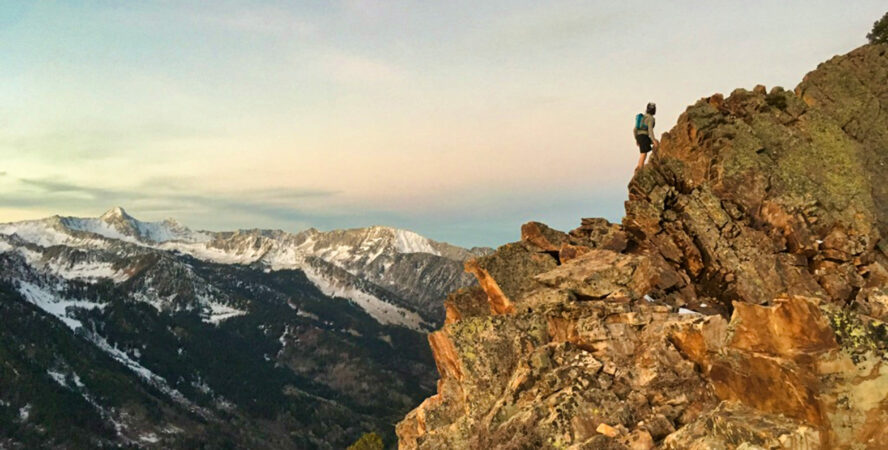
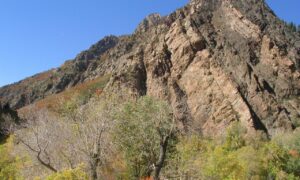


3. Salt Lake City - Good to Know
single pitch, multi-pitch
Quartzite, granite, limestone
Spring, fall
Big Cottonwood Canyon: Dogwood Crag
Salt Lake City mountain biking is some of the best in Utah; in winter, it’s equally good for backcountry skiing
Friendly to sleeping in your vehicle; Dogwood
Campground
4. Maple Canyon
Located on the east side of the mountains, southeast of the town of Fountain Green, Maple Canyon is secluded and maintained by the Forest Service. Conglomerate rock may best be described as a riverbed that became vertically oriented. Compressed into a cement-like base called a “matrix,” cobbles of quartzite and other rock types stick out like your favorite gym slopers. This rock gives us the incredible sport climbing destination that is Maple Canyon.
What to expect from climbing Utah’s conglomerate rock
I certainly found climbing on conglomerate for the first time challenging as the orientation of the rocks is random and the holds are often slick. Taking time to practice orienting your body to the shape of the holds helps so much. This is especially true because much of Maple is steep, making this a difficult task.

My all-time favorite climbs in Maple Canyon
My favorite area to warm up to Maple is Zen Garden where, while steep, there are plenty of grades (5.9) and well-bolted routes to get your feet wet. Routes such as Zen Fen and Zen Jen (5.9) serve as excellent warm-ups. Zen Master is the star of the show here (5.10d), however, I think Mini Meditation (5.10c) is the better of the routes. Just across and back towards the road is the Minimum Crag. It hosts an excellent selection of harder routes (5.11-5.12) complete with easier (5.5-5.6) just to the right. My personal favorite is 49 (5.12a)!
If you’re seeking a host of more challenging routes, as well as a slot canyon experience, Box Canyon towards the mouth of Maple Canyon has what you are looking for. With routes ranging from 5.10-5.13+, you’ll likely find your test piece here. With many of the harder routes equipped with parma-draws, you might feel like you’re in an outdoor gym. Routes such as Downloader (5.11) and Watermelon Sugar (5.12a) will surely have you smiling during your descent.
Best time to visit Maple Canyon to enjoy the weather
The main road also doubles as your campground which can become impassable by November due to snow, so plan for early fall at the latest. Snow may also cover the road well into May as well. Situated at just below 7,000 feet, Maple stays cool even in the height of the summer time where shade is easily found within the maze of drainages. My favorite time for rock climbing in Maple Canyon is September where the nights are chilly and the daytime temps are ideal regardless if you’re in sun or shade!

How to get the most out of Utah’s Maple Canyon climbing
If you time your visit right during winter and happen to have a 4X4 vehicle, ice tools and crampons, Maple has some of the best ice climbing in Utah. For easy eats on your rest days, Juanita’s as well as Biggies in Moroni are great. Cavalier Pizza and El Mexicano Restaurant in nearby Mt. Pleasant are also good options. Camping is available in Maple Canyon proper along the access road, managed by the Forest Service for $10. Keep in mind that there is a $5 day use fee in the canyon, however, I have heard that this is covered by your camping payment. The camp host is typically a climber, so I highly recommend you get to know them!
If you’re seeking a host of more challenging routes, as well as a slot canyon experience, Box Canyon towards the mouth of Maple Canyon has what you are looking for.
4. Maple Canyon - Good to Know
Sport
Conglomerate rock
Spring through fall; September is prime
Minimum Crag
Maple Canyon Guidebook by Darren Knezek (older but still recommended)
Hiking, enjoying the solitude
Maple Canyon Campground for $10 per night
Jackson Hole Mountain Guides; Red River Adventures
5. Zion National Park
It is easy to understand how Zion got its name. During my first trip here, I was taken aback by the incredibly steep walls. Unlike Red Rock in Las Vegas, the walls are virtually featureless save for a few crack weaknesses. Given this reality of the geology, it is no wonder why the rock climbing in Zion feels otherworldly and exposed. The park is often referred to as the sandstone Yosemite, as the positions are often reminiscent of the valley but instead offer desert surroundings. It contains just about every style of climbing, including free, aid, bouldering, single pitch and multi-pitch climbing. Zion is sure to please any visiting climber, whether they’re just passing through or staying for a few days. I recommend the latter!

The land of the gods is a playground for climbers
Zion was long referred to as a sacred place where gods lived and was known as Mukuntuweap. It’s the native land of ancestral Puebloan, Fremont and other tribes and eventually the Paiute. In addition to being rich with history, add the flowing waters of the Virgin River underneath you, and it is little wonder why Zion is so popular. Fortunately for the visiting climber, your route often bypasses the hikers.
You won’t want to miss my first ‘big wall’ climb in Zion
For many, the biggest draw for climbing in Zion is the big walls that you can achieve in one or even two days with limited aid experience. While only eight to ten pitches long, routes like Moonlight Buttress, Prodigal Sun and Touchstone Wall are typically referred to as Grade IV or Grade V. These routes are graded challenging because of their difficulty going free (5.12+) or their need for moderate aid climbing. My first “big wall” in Zion was Moonlight Buttress. My partner and I hauled up a crappy old Metolius portaledge and spent a fantastic night on our ever tilting platform watching the sunset. Truly a majestic experience from the start to the finish!
Some of my favorite routes to climb around Zion
For a less committing time, The Headache (5.10) on the Mt. Carmel Tunnel area is an excellent three-pitch route that is mostly a hand crack of varying sizes from start to finish. Certainly not worthy of its name, this route is anything but a headache! Navajo sandstone does not often lend itself to amazing cracks, so don’t pass this one up.
Zion also has some great single pitch routes, some of which rival the climbing in Red River Gorge. Located in Kolob Canyon, the Namaste Wall was discovered to be an ideal spot for climbing by Conrad Anker. It is the quintessential hueco climbing area. Otherwise blank, red and purple sandstone with dark black streaks from millennia of running water has created an otherworldly series of huecos that just beg to be climbed. The routes here range from 1/2 Route (5.10+ with a 3 bolt 5.11 extension) is 80 feet tall. The nearby namesake route, Namaste, stands at 140 feet tall at 5.12a.
How to get the most out of your time climbing Zion
As a national park, Zion requires an entrance fee just like any national park that is good for seven days from purchase. My personal preference is to purchase the interagency pass at any entrance station for $80 that is good at any land managed by the Dept. of the Interior or Forest Service. Between March and November, no cars are allowed past the visitor center, so be ready to take the reliable shuttle busses into the canyon. If the visitor center is full, the nearby town of Springdale has paid parking for reasonable prices. If bivying a big wall overnight, then a fee of $15 for a permit is needed either purchased online and picked up at the ranger station/visitor center or purchased there.
How to find camping near Zion
Zion has become very crowded due to increased popularity, so be prepared to either pay for camping in Springdale or Rockville. I recommend campgrounds in areas such as Watchmen Campground or drive over to nearby Virgin to find BLM land, which can be found on apps such as iOverlander. Zion Pizza and Noodle Company certainly have my favorite atmosphere for rest day eats.
Otherwise blank, red and purple sandstone with dark black streaks from millennia of running water has created an otherworldly series of huecos that just beg to be climbed.
5. Zion National Park - Good to Know
Free, aid, single-pitch, multi-pitch
Sandstone
Spring, fall
Moonlight Buttress is a great first “big wall”
Zion Climbing: Free and Clean by Bryan Bird
Visit the national park sights, hiking, trail running
Watchmen Campground, BLM land near Virgin
Zion Mountain School
6. St. George and Hurricane
If arriving in Utah from the south or heading to Zion, you can’t help but drive through or near St. George and Hurricane. The St. George area is host to similar rock types as the rest of Southwest Utah, these under-the-radar towns hold many many single-pitch crags on rock ranging from short Basalt sport/trad areas at Black Rocks, amazing limestone in the Hurricane and Utah Hills and awesome, overhanging sport routes on sandstone at Chuckwalla Wall.

Some amazing multi-pitch adventures await in the Snow Canyon State Park, which charges an entrance fee of $10 and $20 per night for camping. I love these areas because when everything else in the country is cold, these areas are often in the sun and warm. I especially appreciate the limestone sport climbing if neighboring Red Rock, Nevada gets rain.
Where to go in St. George and Hurricane
All of these areas have one thing in common and that is that most are located on or near BLM land that is free to stay on. You must be very wary of camping near towns as many of that land is bordering flashy neighborhoods. Likely due to the popularity of this area, residents are less than psyched to have vans and tents set up on free public land just outside of their doorsteps. The Utah Hills has a plethora of public land that is roadside camping friendly. Near Hurricane and the town of Virgin, there is excellent, but sometimes crowded, free camping! My favorite places to go for eats are the River Rock Roasting company just north of Hurricane and George’s Corner Restaurant in St George.
I love the St. George and Hurricane areas because when everything else in the country is cold, and even other parts of Utah, these areas are usually sunny and warm.



6. St. George and Hurricane - Good to Know
Sport, trad
Basalt, limestone, sandstone
Spring, fall
The Limestone Bible by Misty Murphy & Bill Ohran
Bike, hike, ride a horse, fish, or canyoneer, all in close proximity
Snow Canyon State Park at $20 per night of camping
My Advice for Planning Your Utah Climbing Trip
Enjoy a long climbing season if you can tolerate temperature swings
The climbing season in Utah is long, or short, depending on your tolerance to varying temperatures. Prime time climbing in Utah is similar across the state. Spring and fall are the ideal, as they are the most temperate times of year to visit. In certain mountain areas, even southern regions such as Zion, temps fall quicker because of the elevation in certain areas. It’s not unusual to wake up with frost on your tent in late September near Zion. Depending on the aspect, however, you can find sun and shade at your convenience and climb into the late parts of spring to early summer and late summer to fall.
Tips to find camping in Utah
The Bureau of Land Management camping sites, better known as BLM land, is all over the West and offers free camping across Utah. Many are undesignated and all are first come, first served. BLM land can be found on apps such as iOverlander. By now, you’re probably not surprised to hear free camping in Utah tends to be popular. Utah is extremely well-visited thanks to its trifecta of national parks and a multitude of state attractions — and for good reason! The trick is to plan ahead, arrive early and stay open.

Things to know about climbing in Utah
If you want to visit Utah’s national parks for climbing or on rest day, you’ll need to pay park entrance fees. My personal preference is to simply purchase the interagency pass at any entrance station for $80 that is good at any land managed by the Dept. of the Interior or USDA (Forest Service).
Consider BYOB due to Utah’s strict liquor laws
Beverages bought anywhere other than a state-run liquor store caps at 5% alcohol content and is only beer. Beer, liquor and wine purchased at the state-run liquor store is sold as singles (more expensive) and is always unrefrigerated. If buying full percentage beer in a restaurant, it must be purchased in a can, opened by the staff and poured yourself. Have fun figuring out the others! My advice: Stock up before you arrive!

